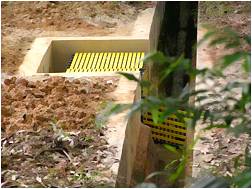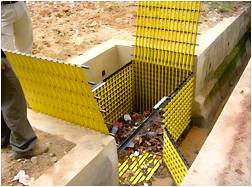Difference between revisions of "Practitioner's Tool / Determining Pretreatment Needs – Markets"
(→Solids and Trash) |
m (Winona moved page Practitioner's Tool / Planning and Promotions / Determining Pretreatment Needs – Markets to Practitioner's Tool / Planning and Promotions / 6. Determining Pretreatment Needs – Markets without leaving a redirect) |
(No difference)
| |
Revision as of 18:54, 23 September 2016
Solids and Trash
Excessive solids in wastewater are caused by trash entering the sewer system or generated by processes at the facility. It enters the wastewater stream and then has to be removed at the treatment process. Converting open sewer channels to piped sewers can dramatically reduce trash entering the wastewater stream. Trash traps at public markets for fish, meat and vegetable stalls is required.
Trash traps are simple devices that prevent solid waste from flowing down the drains and causing drainage problems. Traps are often located at strategic locations on the wastewater collection system. Remember that trash traps must be cleaned frequently, and the screenings should be placed in covered receptacles and disposed of as solid waste.
There are two main types of trash traps for markets. The first - pictured to the right - is a mesh box developed by researchers in Kuala Lumpur for channelized sewers. Its design is flexible and easy to install. It can be designed to fit into sewer channels at strategic locations selected to trap the most solids. Hinged lids and doors make this unit especially easy to clean and maintain. Plastic coated metal components protect against corrosion, making this an extremely durable product.
Since the development of Drainage Trash Trap System, it has been installed successfully in Universiti Teknologi Malaysia, Skudai, Johore, Taman Universiti, Skudai, Johore and near wholesale market in Selayang, Selangor. One scale down model also has been developed to study the usage and effectiveness of DTTS. This product has won a Silver Medal at the 5th Invention and Innovation Competition held during the Malaysia Technology Expo 2006 from 23 – 25 February 2006 at the Putra World Trade Centre, Kuala Lumpur.
| DTTS was developed under the collaboration between NAHRIM-NRE, the government agencies and Dr Fikri & Associates Sdn Bhd, a private company.
Contact Person: Dr Mohamed Roseli bin Zainal Abidin (Director) |
The second style of trap suitable for markets is shown in the diagram to the left. Designed for piped and not canalized sewers this one is made of concrete and can be retrofit. This is a low cost option that can be constructed on-site using locally available materials and labor.
Costs for Sanitation Options for Markets
Other Pretreatment Issues for Markets: Markets with food preparation or utensil washing should follow the pretreatment recommendations for restaurants, including installing grease traps.



